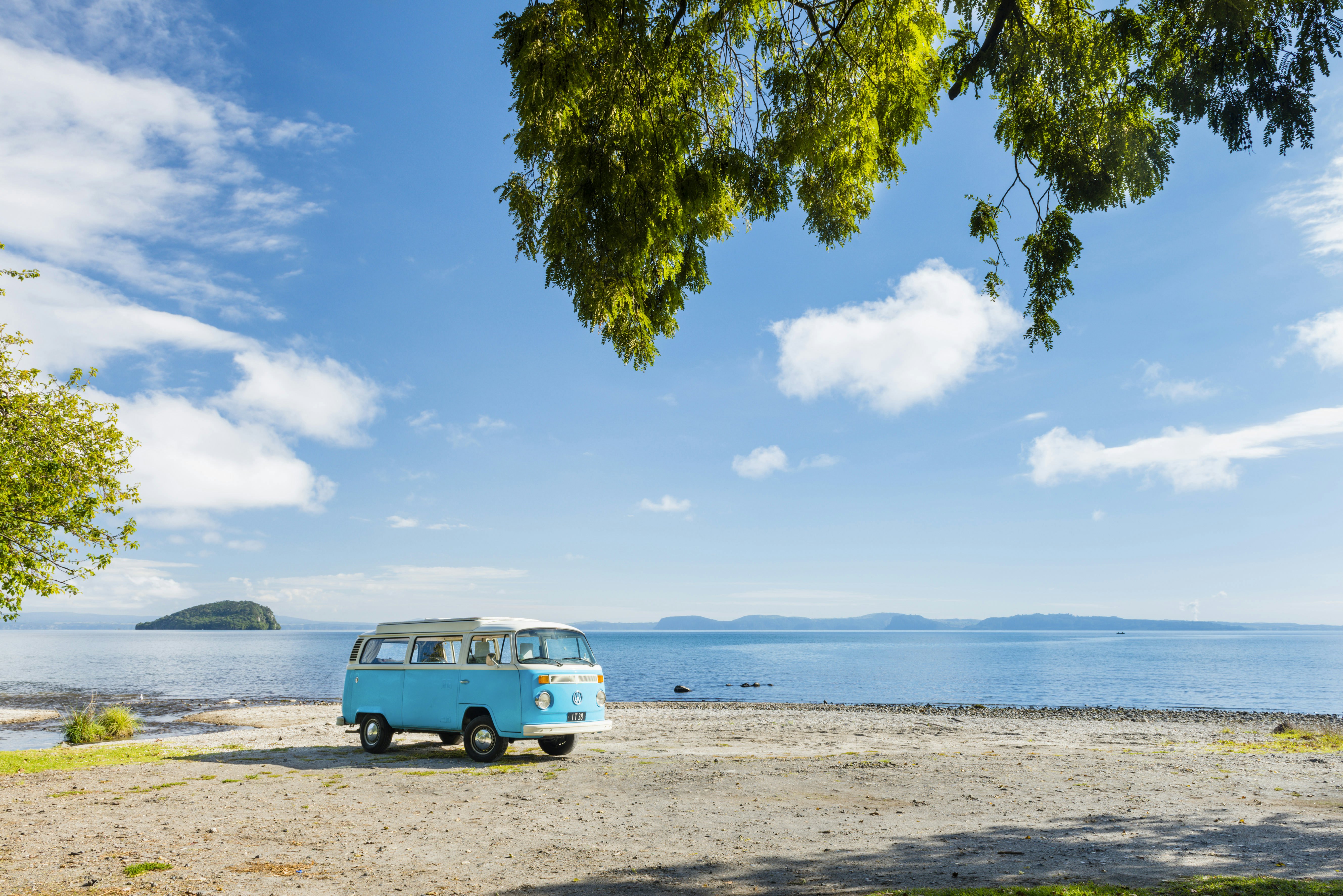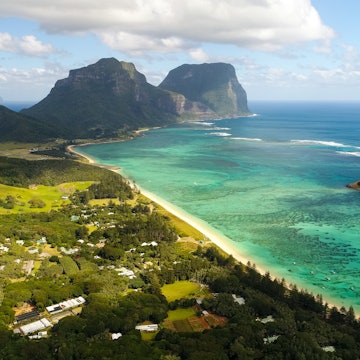

Freedom camping requires a self-contained camper © Justin Foulkes / Lonely Planet
Unless you’re sailing from Australia or a Pacific island, getting to New Zealand is always going to require flying – something many are reconsidering as they look to reduce their carbon output from air travel. The good news is once you’re in this beautiful country, there are many ways to travel sustainably. It's possible to keep your carbon footprint low, and your enjoyment high.

Get around the low-impact way by hike, bike or sail
One of the lowest-emission ways to travel is by using your own energy, and New Zealand is one of the best destinations to do just that. Whether its cycling, hiking, canoeing and kayaking, or sailing – you will not only immerse yourself in NZ’s staggering natural beauty, these activities are good for your physical and mental health too. Hikers should pick up a copy of Hiking & Tramping New Zealand – ideal preparation for one of New Zealand’s Great Walks. Take on a multi-day epic, which requires carrying your own food, clothes and water, or if you don’t fancy lugging the extra gear, it also covers shorter day walks.
Once in NZ you’ll find local tour operators running experiences from a few hours to a few days so you can sustainably traverse the country. You can literally cycle from one side of NZ to the other on the 87km-long Twin Coast Cycle Trail in Northland.

Hire an electric camper van
One of the most popular ways to see New Zealand is by camper van. When you hire a camper van you have your accommodation and transport in one package, saving time repacking and checking in and out of hotels, motels or hostels. Britz now hires e-campers with inbuilt navigation that helps you find fast-charging stations. It takes 10 to 45 mins to top up your e-camper battery (while you stretch your legs and grab a coffee nearby). Plugshare also shows all the high-powered charging stations so get road trip planning before you go. But, e-camper vans can also re-charge for free at holiday parks with powered sites, so while you’re sleeping your van is topping up power for the next day’s travel! If you’re not staying, most also offer e-vehicle top ups for a small fee (around $6).
Select carbon-neutral accommodation
YHA, New Zealand’s hostels network, was the first worldwide to be certified net carbon-neutral by improving insulation, upgrading to energy efficient appliances and fixtures, and switching to passive energy sources. Smarter power monitoring means YHA hosts can identify where in a hostel more energy is being used, and then explain to guests how their actions (or inaction) have consequences. For more green accommodations and ecotourism ventures check out Organic Explorer.

Choose eco behaviour and greener destinations
These days the Māori ethos of kaitiakitanga (guardianship/protection) is part of the everyday practise of Pākeha (white) New Zealanders too. Locals are collectively working on green goals like taking out 'exotic' trees to encourage native birds; informing visitors about their part in pest control (the ambition is to get rid of possums, rodents and other unwelcome critters that have impacted the local wildlife, like kiwis, across the country); and are switching to green energy sources like solar and geothermal power.
Some New Zealand destinations that are not as high on the visitor radar as Queenstown or Rotorua are developing from the outset as 'green' destinations. Take Great Barrier Island (Aotea) for example, just a four-hour ferry ride from Auckland. It was the first island in the world to be declared a Dark Sky Sanctuary in 2017, making it a must-visit for star gazers. Operators here are taking a lead in NZ on green initiatives like the off-grid Aotea Brewing which eskews all single-use containers for recyclable bottles (it sells its own too) to use at its ‘refilleries’ on both the North and South islands. Motu Bikes hires solar-powered electric motorbikes so you can zip around the forest roads and white sand beaches of this island paradise without burning up the atmosphere.

Opt for campsites over freedom camping
Freedom camping – or camping wherever you like – sounds so, well, FREE! It’s a popular choice for travellers on a budget, but its impact in New Zealand has been felt, and there are restrictions, meaning it’s not quite as free as it first seems. Unless you’re pitching your tent in a national park or on private property (with permission from the landowner) then you need to be in a self-contained camper van, which means you must have a shower and toilet on board and you need to know how to dispose of your waste properly. In some car parks, or lay-bys in NZ, there are signs specifically saying that staying there overnight is disallowed and there’s an immediate $200 fine if you are caught. Other towns allow a night or two stay at a maximum.
Freedom camping may save travellers the $15 a night they’d spend on a basic campsite run by the Department of Conservation (DOC), but there’s always a cost, which is why some New Zealanders have had it with the whole ‘freedom camping’ concept. Many of the best DOC campsites actually face on to beaches, rivers and forests, so going ‘free’ doesn’t always mean getting the choice spots.
We spoke to Nick Blake who runs the Top 10 Holiday Park in the tropical North Island city of Whāngarei to get a local’s perspective. “Freedom camping is not really sustainable – and it’s not always safe either. When people ‘freedom camp’ someone has to pay for it. That’s normally local rate payers in New Zealand. And then there’s the negative impact of people leaving rubbish behind, ruining NZ for everyone who comes after them.”
Full service holiday parks with hot showers, open-air kitchens, and proper recycling facilities cost a bit more than a DOC site with a drop toilet and no running water, but as Nick explains: “As a business we spend an extra $30,000 to $35,000 per annum to make sure all of our recycling is sent to the correct places and not just put in landfill.” So staying at proper campsites may well be the greener choice.
Do as the Kiwis do
Plastic bag-free shopping is the norm almost everywhere in New Zealand; motels use refillable glass bottles for the milk their in-room tea and coffee station; and take-away coffees or dinner is discouraged. If you really have to order to go, expect to be offered non-plastic biodegradable packages, or bring your own. But, better still, what’s the hurry: sit down in a cafe with the locals and savour that long white coffee.
Offset your own carbon emissions
Finally, if want to go the extra mile and offset your carbon emissions after travelling in NZ, there are myriad ways to calculate your CO² and make a comparable donation to an offset scheme. Some schemes invest in tree planting (New Zealand has an ambitious target to plant one billion trees by 2028), while programmes like Gold Standard focus on generating alternative energy such as low-smoke stoves and solar power infrastructure in developing countries so they develop into low-carbon economies.
However, there are doubts over the real efficacy of some carbon offsetting schemes, and reducing your emissions while on the road is always the best thing you can do. Always do your own independent research before making donations.
You might also like:
How to have a sustainable visit to the Great Barrier Reef
Back to nature: 8 rewilding projects you can visit in Europe
Go off-grid in this luxurious new trailer














![Manukau Heads Lighthouse, Auckland, New Zealand [closeup view] License Type: media Download Time: 2022-02-25T15:39:58.000Z User: bhealy950 Is Editorial: No purchase_order:](https://lp-cms-production.imgix.net/2025-10/Shutterstock1352692988.jpg?auto=format,compress&q=72&fit=crop&w=360&ar=1:1)

